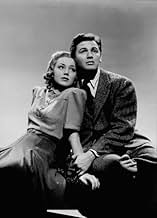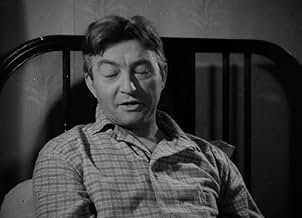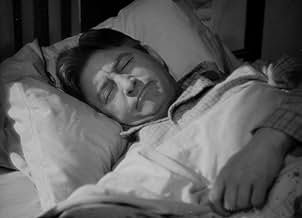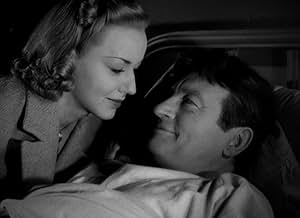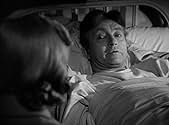Ajouter une intrigue dans votre langueAfter meeting each other as fellow employees at J.B. Martin Co., forthright twenty-two year old Bobby Halevy and twenty-five year old Rims Rosson, who has his head in the clouds in coming up... Tout lireAfter meeting each other as fellow employees at J.B. Martin Co., forthright twenty-two year old Bobby Halevy and twenty-five year old Rims Rosson, who has his head in the clouds in coming up with one useless invention after another, fall in love and get married. The marriage is d... Tout lireAfter meeting each other as fellow employees at J.B. Martin Co., forthright twenty-two year old Bobby Halevy and twenty-five year old Rims Rosson, who has his head in the clouds in coming up with one useless invention after another, fall in love and get married. The marriage is despite Bobby treating this, her first job, as an experience like everything she does and n... Tout lire
- Réalisation
- Scénario
- Casting principal
- Myrtle Halevy
- (as Elizabeth Risdon)
- Clint
- (non crédité)
- Second Carpenter
- (non crédité)
- Greenwich Clinic Nurse
- (non crédité)
- Cab Driver
- (non crédité)
- City Hospital Doctor
- (non crédité)
- Joe
- (non crédité)
- Stamp Collecting Mailman
- (non crédité)
- Mac
- (non crédité)
- Girl at Party
- (non crédité)
Avis à la une
I thought the movie was quite interesting. This is quite amazing as I do not usually enjoy movies from that era. I consider this a holdover from the 1930's; it has "depression and coming war" written all over it.
The questions the movie raised, however dated the movie, were familiar: how do young marrieds survive financially? Should men marry before they have achieved their financial goals? When, or if, should young married women drop out of the work force in order to raise a family? These are questions as difficult today as they must have been nearly 7 decades ago. The most interesting aspect was that these problems existed at all: we tend to think today that these are merely modern questions.
In spite of its "1930 style" I found it riveting; all the more so when one realizes that its stars are all gone, like the era it portrayed.
The film moves along at a quick pace with each conversation talking rapidly just like it most likely did when it was first delivered as a stage play. This is a simple picture about a young couple just starting their lives together when the war efforts directly impacts their ability to maintain a living and possibly to starting a family of their own.
It is a simple story filled with both family hardships and romance and keeping in mind that WWII was underway filmgoers were looking for some glimmer of hope which Anne Shirley and John Garfield deliver. Claude Rains plays Anne Shirley's father with the charm of a lucky leprechaun which is an added bonus.
I give this eighty (80) year old classic film a decent 8 out of 10 IMDB rating
In any event, Bogart left the play after a few months to then assume his next role on the Broadway stage in a farce entitled "Baby Mine.". It opened on June 9, 1927 and closed unsuccessfully after just 12 performances. The play starred Roscoe "Fatty" Arbuckle, and was intended to be a comeback vehicle for Arbuckle from a well known scandal that ultimately doomed him as an actor in Hollywood.
Garfield's role in SC is not like the work he was doing at Warner Brothers at this stage of his career. He played it in a somewhat subdued and understated way that greatly enhanced both its realism and charm. Some reviewers have suggested that Garfield was miscast in this role. Others have opined that he took it on to show that he had a broader acting range than he was able to demonstrate in his previous WB films. The latter explanation seems to be the more plausible one, based upon the many examples of similar efforts made by other Hollywood actors presented with like situations. See e.g. Fred Astaire in On the Beach (1959), Gene Kelly in Inherit the Wind (1960), Lucille Ball in The Big Street (1942), Frank Sinatra in Suddenly (1954), Bob Hope in Beau James (1957) etc. Bogart's assuming an atypical (for him) romantic and comedic leading man role in Sabrina (1954) would appear to be yet another illustration of the same phenomenon. To this reviewer, Garfield was believable, likable and quite natural playing Rimes. It is possible that under the right set of circumstances, Garfield (like James Cagney and Edward G. Robinson before him) might have also developed into a reasonably successful comedic actor. Again-----unfortunately-----we will never know.
SC is a sensitive and touching film that was greatly aided by Garfield's likable and boyish performance. Special mention also must be made of Claude Rains's nuanced portrayal as Anne Shirley's warm and kindly father. The rest of the supporting cast was strong and greatly enhanced the story's Depression-era narrative.
To many filmgoers, SC is probably an unknown or forgotten movie. Because it is so endearing, SC deserves to be seen and appreciated anew by a contemporary audience.
The story takes place in Manhattan at the end of the Great Depression. Based on a play by Maxwell Anderson, it probably worked better on the stage than in the adaptation that Julius Epstein, one of the best writers of the period, gave it. It doesn't help either, that director Vincent Sherman didn't appear to be too enthused with the material, as evident in the finished product.
John Garfield was totally wrong for Rims Rosson. He doesn't have that spark that was his trade mark. In the film he is just too bland. Ann Shirley plays the sweet Bobby Halevy. Claude Rains, though, is about the most likable character in the film because as the father of Bobby, he is an honest man who wants to do everything possible to guarantee his daughter's happiness.
The supporting cast is excellent. Lee Patrick, is seen as Florrie. Roscoe Karns and the always dependable George Tobias, make good contributions in minor roles.
Watch "Saturday's Children" as dated curiosity piece.
Le saviez-vous
- AnecdotesJames Stewart was to play "Rims Rosson" but was replaced by John Garfield. Jane Bryan was to play "Bobby Halevy", but she retired to get married and was replaced by Olivia de Havilland, who was suspended after she refused the part. Una Merkel had the role of "Florrie Sands" but was replaced by Lee Patrick after she became ill.
- GaffesThe credits of this film say "Based on the Pulitzer Prize play by Maxwell Anderson." The play did not win the Pulitzer Prize, but Anderson won the 1933 Prize for another play, "Both Your Houses".
- Citations
Willie Sands: Two can live as cheap as one... if one don't eat!
- ConnexionsFeatured in The John Garfield Story (2003)
- Bandes originalesLa Cucaracha
(uncredited)
Traditional
Played as dance music at the going away party
Meilleurs choix
Détails
- Date de sortie
- Pays d’origine
- Langues
- Aussi connu sous le nom de
- Married, Pretty and Poor
- Lieux de tournage
- Manhattan, Ville de New York, New York, États-Unis(opening establishing shots - archive footage)
- Société de production
- Voir plus de crédits d'entreprise sur IMDbPro
- Durée
- 1h 42min(102 min)
- Couleur
- Rapport de forme
- 1.37 : 1

